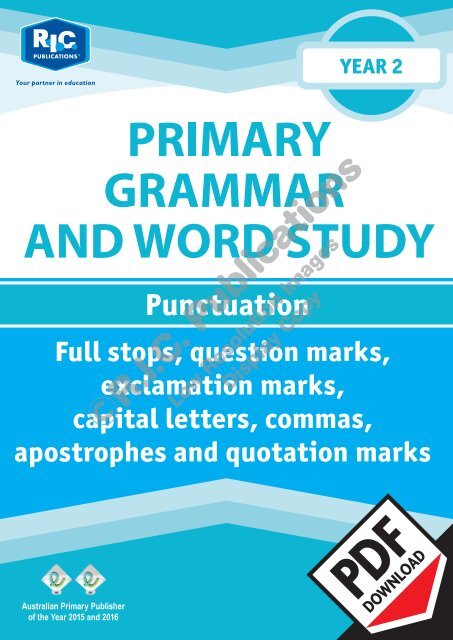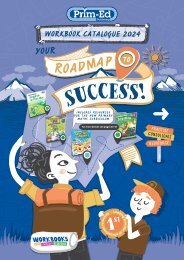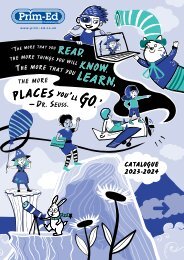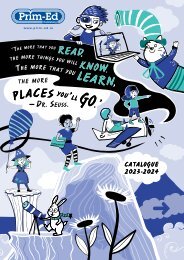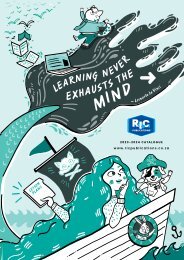RIC-20232 Primary Grammar and Word Study Year 2 – Punctuation
You also want an ePaper? Increase the reach of your titles
YUMPU automatically turns print PDFs into web optimized ePapers that Google loves.
©R.I.C. Publications<br />
Low Resolution Images<br />
Display Copy
<strong>Primary</strong> grammar <strong>and</strong> word study (Book C)<br />
Published by R.I.C. Publications ® 2008<br />
Copyright © by R.I.C. Publications ® 2008<br />
This master may only be reproduced by the<br />
original purchaser for use with their class(es). The<br />
publisher prohibits the loaning or onselling of this<br />
master for the purposes of reproduction.<br />
<strong>RIC</strong><strong>–</strong><strong>20232</strong><br />
Copyright Notice<br />
Blackline masters or copy masters are published <strong>and</strong><br />
sold with a limited copyright. This copyright allows<br />
publishers to provide teachers <strong>and</strong> schools with a<br />
wide range of learning activities without copyright<br />
being breached. This limited copyright allows the<br />
purchaser to make sufficient copies for use within<br />
their own education institution. The copyright is not<br />
transferable, nor can it be onsold. Following these<br />
instructions is not essential but will ensure that you,<br />
as the purchaser, have evidence of legal ownership<br />
to the copyright if inspection occurs.<br />
For your added protection in the case of copyright<br />
inspection, please complete the form below. Retain<br />
this form, the complete original document <strong>and</strong> the<br />
invoice or receipt as proof of purchase.<br />
Name of Purchaser:<br />
Date of Purchase:<br />
Supplier:<br />
School Order# (if applicable):<br />
Signature of Purchaser:<br />
©R.I.C. Publications<br />
Low Resolution Images<br />
Display Copy<br />
Internet websites<br />
In some cases, websites or specific URLs may be recommended. While these are checked <strong>and</strong> rechecked at the time of publication,<br />
the publisher has no control over any subsequent changes which may be made to webpages. It is strongly recommended that the class<br />
teacher checks all URLs before allowing students to access them.<br />
View all pages online<br />
PO Box 332 Greenwood Western Australia 6924<br />
Website: www.ricpublications.com.au<br />
Email: mail@ricgroup.com.au
<strong>Primary</strong> grammar <strong>and</strong><br />
word study <strong>–</strong> Book C<br />
Foreword<br />
<strong>Primary</strong> grammar <strong>and</strong> word study is a series of seven books designed<br />
to introduce students to parts of speech, ways to underst<strong>and</strong> <strong>and</strong> choose<br />
words, punctuation <strong>and</strong> figures of speech.<br />
Titles in this series:<br />
• <strong>Primary</strong> grammar <strong>and</strong> word study Book A (Ages 5<strong>–</strong> 6)<br />
• <strong>Primary</strong> grammar <strong>and</strong> word study Book B (Ages 6<strong>–</strong>7)<br />
• <strong>Primary</strong> grammar <strong>and</strong> word study Book C (Ages 7<strong>–</strong>8)<br />
• <strong>Primary</strong> grammar <strong>and</strong> word study Book D (Ages 8<strong>–</strong>9)<br />
• <strong>Primary</strong> grammar <strong>and</strong> word study Book E (Ages 9 <strong>–</strong>10)<br />
• <strong>Primary</strong> grammar <strong>and</strong> word study Book F (Ages 10<strong>–</strong>11)<br />
• <strong>Primary</strong> grammar <strong>and</strong> word study Book G (Ages 11<strong>–</strong>12)<br />
Teachers notes .............................................. iv <strong>–</strong> v<br />
English curriculum links ....................................... v<br />
Literacy character explanation ...................... vi <strong>–</strong> vii<br />
Checklists.................................................... viii <strong>–</strong> xi<br />
Parts of speech .............................................. 2<strong>–</strong>33<br />
Nouns .............................................................. 2<strong>–</strong>5<br />
Verbs .............................................................. 6<strong>–</strong>11<br />
Adjectives..................................................... 12<strong>–</strong>17<br />
Adverbs ........................................................ 18<strong>–</strong>21<br />
Pronouns ...................................................... 22<strong>–</strong>25<br />
Conjunctions ................................................ 26<strong>–</strong>27<br />
Determiners ................................................. 28<strong>–</strong>31<br />
Prepositions ................................................ 32<strong>–</strong>33<br />
Underst<strong>and</strong>ing <strong>and</strong> choosing words .......... 34<strong>–</strong>57<br />
<strong>Word</strong>s that are similar ............................. 34<strong>–</strong>45<br />
Homographs ............................................ 34<strong>–</strong>35<br />
Homophones ............................................ 36<strong>–</strong>37<br />
<strong>Word</strong> groups ............................................ 38<strong>–</strong>45<br />
<strong>Word</strong>s that change ..................................... 46<strong>–</strong>49<br />
Plurals ...................................................... 46<strong>–</strong>49<br />
Contents<br />
<strong>Word</strong>s <strong>and</strong> their meanings ........................ 50<strong>–</strong>53<br />
Synonyms ................................................ 50<strong>–</strong>51<br />
Antonyms ................................................. 52<strong>–</strong>53<br />
Confused words ......................................... 54<strong>–</strong>57<br />
<strong>Punctuation</strong> ................................................. 58<strong>–</strong>71<br />
Full stops ..................................................... 58<strong>–</strong>59<br />
©R.I.C. Publications<br />
Low Resolution Images<br />
Display Copy<br />
Question marks <strong>and</strong> exclamation marks ....... 60<strong>–</strong>61<br />
Capital letters ............................................... 62<strong>–</strong>63<br />
Commas ....................................................... 64<strong>–</strong>65<br />
Apostrophes ................................................. 66<strong>–</strong>69<br />
Quotation marks ........................................... 70<strong>–</strong>71<br />
Figures of speech ........................................ 72<strong>–</strong>83<br />
Alliteration .................................................... 72<strong>–</strong>73<br />
Anagrams <strong>and</strong> palindromes .......................... 74<strong>–</strong>75<br />
Similes ......................................................... 76<strong>–</strong>77<br />
Metaphors .................................................... 78<strong>–</strong>79<br />
Onomatopoeia .............................................. 80<strong>–</strong>81<br />
Personification .............................................. 82<strong>–</strong>83<br />
R.I.C. Publications ® www.ricpublications.com.au iii<br />
<strong>Primary</strong> grammar <strong>and</strong> word study
<strong>Punctuation</strong> checklist<br />
Name of student Full stops Question marks<br />
Exclamation<br />
marks<br />
Capital letters Commas Apostrophes<br />
Quotation<br />
marks<br />
©R.I.C. Publications<br />
Low Resolution Images<br />
Display Copy<br />
<strong>Primary</strong> grammar <strong>and</strong> word study x<br />
www.ricpublications.com.au R.I.C. Publications ®
<strong>Punctuation</strong><br />
Full stops<br />
Focus<br />
Full stops at the end of a sentence<br />
Full stops for abbreviations<br />
Definitions<br />
• Full stops are punctuation marks used to show the<br />
end of a sentence.<br />
Example:<br />
We are going to a special morning tea tomorrow.<br />
• An abbreviation is a shortened form of a word or<br />
phrase. A full stop is used to show that a word has<br />
been abbreviated.<br />
Example:<br />
Monday <strong>–</strong> Mon.<br />
Explanation<br />
• Full stops, also called periods, usually show the end<br />
of an idea or thought in a sentence. They can also<br />
indicate that a break is needed when reading.<br />
• With abbreviations, full stops are not used when<br />
the last letter is the last letter of the word being<br />
abbreviated.*<br />
Example:<br />
street <strong>–</strong> st, Doctor <strong>–</strong> Dr<br />
• The necessity for faster communication has<br />
contributed to some changes.<br />
Abbreviations of proper nouns, such as New South<br />
Wales (NSW), no longer need full stops. They are<br />
now only used to avoid possible confusion.<br />
Example:<br />
R.I.C. Publications ®<br />
The full stops are used to indicate pronunciation.<br />
Worksheet information<br />
• Only abbreviations using full stops are used for this<br />
worksheet.<br />
• Read <strong>and</strong> discuss the information at the top of the<br />
worksheet.<br />
• Full stops to indicate the end of a sentence should<br />
be added to the text in Question 1.<br />
• Read the instructions for Question 1 (b) <strong>and</strong> allow<br />
the students to complete the puzzle independently.<br />
• It is likely that students have encountered<br />
abbreviations of days <strong>and</strong> months on calendars. A<br />
calendar with abbreviations can be shown to the<br />
students to assist them to complete Question 2.<br />
Ideas for further practice<br />
• Find <strong>and</strong> list other abbreviations—those with <strong>and</strong><br />
without full stops.<br />
• Discuss abbreviations which the students may be<br />
familiar with relating to SMS messaging.<br />
• Students select a portion of text (paragraph) from a<br />
library or reading book <strong>and</strong> count the number of full<br />
stops. Hold a competition to see who can find the<br />
most full stops in a block of text.<br />
Answers<br />
1. (a) On Friday, 6 December, I finally sent my editor<br />
the final pages of my book. I was so relieved<br />
to finally be finished! The last few pages of the<br />
last chapter took a long time to write, but I was<br />
really pleased when they turned out so well. I<br />
hope my book sells well, but even if it doesn’t,<br />
I will be pleased to see it in print.<br />
(b)<br />
1.<br />
C<br />
3.<br />
H<br />
D<br />
P A G E S<br />
©R.I.C. Publications<br />
Low Resolution Images<br />
Display Copy<br />
P<br />
C<br />
T E D I T O R<br />
E<br />
R<br />
5.<br />
2.<br />
4.<br />
M<br />
B<br />
E<br />
F R I D A Y<br />
2. (a) Mon. (b) Tu., Tue. or Tues.<br />
(c) Wed. (d) Th., Thu., Thur. or Thurs.<br />
(e) Sat. (f) Sun. (g) Jan.<br />
(h) Feb. (i) Mar. (j) Apr.<br />
(k) Jun. (l) Jul. (m) Aug.<br />
(n) Sep. or Sept. (o) Oct. (p) Nov.<br />
*R.I.C. Publications ® employs full stops for<br />
abbreviations as recommended by the Style manual<br />
for authors, editors <strong>and</strong> printers, sixth edition, 2002.<br />
<strong>Primary</strong> grammar <strong>and</strong> word study 58<br />
www.ricpublications.com.au R.I.C. Publications ®
Full stops<br />
Full stops are used to end a sentence. Full stops can also<br />
show that a word has been shortened. These words are<br />
called abbreviations.<br />
1. (a) Add full stops at the end of the sentences in the text below.<br />
On Friday, 6 December, I finally sent my editor the final pages of my<br />
book I was so relieved to finally be finished The last few pages of the<br />
last chapter took a long time to write, but I was really pleased when they<br />
turned out so well I hope my book sells well, but even if it doesn’t, I will<br />
be pleased to see it in print<br />
(b) Find the words in the text which<br />
match the abbreviations. Then<br />
write the whole word to<br />
complete the crossword.<br />
Across<br />
3. pp.<br />
4. ed.<br />
5. Fri.<br />
2. Write abbreviations for the words below.<br />
(a) Monday<br />
(c) Wednesday<br />
Down<br />
1. ch.<br />
2. Dec.<br />
(b) Tuesday<br />
(d) Thursday<br />
(e) Saturday (f) Sunday<br />
3.<br />
1.<br />
5.<br />
©R.I.C. Publications<br />
Low Resolution Images<br />
Display Copy<br />
2.<br />
4.<br />
(g) January<br />
(h) February<br />
(i) March (j) April<br />
(k) June (l) July<br />
(m) August<br />
(o) October<br />
(n) September<br />
(p) November<br />
R.I.C. Publications ® www.ricpublications.com.au 59<br />
<strong>Primary</strong> grammar <strong>and</strong> word study
<strong>Punctuation</strong><br />
Question marks <strong>and</strong> exclamation marks<br />
Focus<br />
Question marks <strong>and</strong> exclamation marks<br />
Definitions<br />
• Question marks are punctuation marks used to<br />
indicate a question.<br />
Example:<br />
What are you doing?<br />
• Exclamation marks are punctuation marks used<br />
at the end of a remark to show strong emotion or<br />
feeling.<br />
Example:<br />
Stop that! Wow!<br />
Explanation<br />
• A question is an interrogative statement, addressed<br />
to someone in order to find out information. When<br />
speakers ask a question, their voice is usually raised<br />
at the end rather than going down or remaining the<br />
same as it does for a sentence. A question mark<br />
looks like an upside down hook <strong>and</strong> is used after a<br />
direct question. Questions often begin with words<br />
such as who, what, when, where, how <strong>and</strong> why.<br />
• Exclamation marks usually indicate strong feeling,<br />
such as surprise, misery, excitement, disgust,<br />
anger or joy. Using an exclamation mark when<br />
writing is like raising your voice when speaking.<br />
An exclamation mark can be used at the end of an<br />
interjection (Oh no!) or a comm<strong>and</strong> (Don’t touch!)<br />
<strong>and</strong> to add emphasis.<br />
Worksheet information<br />
• Students will be familiar with full stops <strong>and</strong> question<br />
marks <strong>and</strong> would have encountered exclamation<br />
marks while reading.<br />
• Read <strong>and</strong> discuss the explanation about question<br />
marks <strong>and</strong> exclamation marks with the students.<br />
Give examples of each <strong>and</strong> find some in shared<br />
reading books, then ask the students to find others.<br />
Emphasise the need for expression to reinforce the<br />
fact that exclamation marks are used to indicate<br />
strong feelings.<br />
• Explain the instructions for Question 1 <strong>and</strong> allow<br />
students to read the text, assisting with unfamiliar<br />
vocabulary. Students may wish to use different<br />
coloured pencils or markers to highlight the question<br />
marks <strong>and</strong> exclamation marks. When highlighting<br />
the exclamation marks, ask them to choose a<br />
‘strong’ colour to represent ‘strong feelings’.<br />
• To complete Question 2, students may need to<br />
quietly say the sentences aloud to determine which<br />
ones indicate strong feeling. Ask the students to<br />
look for clue words, such as ‘who’, ‘what’ etc. to<br />
help them identify questions. The use of exclamation<br />
marks is in some cases subjective, but overuse can<br />
reduce their impact.<br />
Ideas for further practice<br />
• Find <strong>and</strong> read sentences where the ‘questioning’<br />
word such as ‘who’, ‘does’ etc. is not at the<br />
beginning of a sentence.<br />
• Make a list of the students’ favourite exclamations<br />
<strong>and</strong> write them with the exclamation marks in a<br />
bold, strong colour.<br />
• Read plays that encourage the expression of strong<br />
emotions.<br />
Answers<br />
©R.I.C. Publications<br />
Low Resolution Images<br />
Display Copy<br />
1. Teacher check<br />
2. (a) exclamation mark, full stop<br />
(b) full stop<br />
(c) question mark<br />
(d) exclamation mark<br />
(e) question mark<br />
(f) full stop<br />
<strong>Primary</strong> grammar <strong>and</strong> word study 60<br />
www.ricpublications.com.au R.I.C. Publications ®
Question marks <strong>and</strong><br />
exclamation marks<br />
Question marks are used at the end of sentences that ask<br />
about things.<br />
Exclamation marks are used at the end of sentences to<br />
show strong feelings.<br />
1. Read the poem <strong>and</strong> circle the question marks <strong>and</strong><br />
underline the exclamation marks.<br />
Where does the wind come from?<br />
Where does it go when it no longer plays?<br />
Does it fade like the mist on a sunny day<br />
Or fly back to its home?<br />
How cool it must be to soar <strong>and</strong> glide,<br />
Tossed around without a care!<br />
But sometimes I wish it would just behave<br />
And not mess up my hair!<br />
2. Use the correct mark at the end of each sentence. Choose from a full stop,<br />
a question mark <strong>and</strong> an exclamation mark.<br />
(a) Look<br />
©R.I.C. Publications<br />
Low Resolution Images<br />
Display Copy<br />
The sailboat is skimming across the lake<br />
(b) The wind is like a naughty child with a bad temper<br />
(c) Why are the leaves being tossed around<br />
(d) Behave yourself<br />
(e) Would you like to be the wind<br />
(f)<br />
The wind sometimes makes little whirlwinds<br />
R.I.C. Publications ® www.ricpublications.com.au 61<br />
<strong>Primary</strong> grammar <strong>and</strong> word study
<strong>Punctuation</strong><br />
Capital letters<br />
Focus<br />
Capital letters at the beginning of sentences<br />
Capital letters for proper nouns<br />
Definitions<br />
• Capital letters are upper case letters used to begin<br />
a sentence, for proper nouns <strong>and</strong> for titles.<br />
Example:<br />
My mum’s friend came for lunch today.<br />
Mrs Okley never seems to stop talking.<br />
The lion, the witch <strong>and</strong> the wardrobe*<br />
• Proper nouns are nouns used to name particular<br />
people, places or things.<br />
Example:<br />
Dr Brooks, London, Mediterranean Sea, Ocean<br />
Crescent<br />
Explanation<br />
• Capital letters are needed for the first word in a<br />
sentence. They are larger than most lower case<br />
letters.<br />
• Proper nouns can be considered ‘special’ nouns<br />
<strong>and</strong> so are written with capital letters. Proper nouns<br />
include people’s names, names of places, days of<br />
the week, months, holidays <strong>and</strong> festivals, countries,<br />
nationalities, languages <strong>and</strong> religions.<br />
Worksheet information<br />
• Give the students sufficient time to read through the<br />
text. Assist with any words which may be unfamiliar,<br />
such as the made-up country names.<br />
• Read <strong>and</strong> discuss the information about capital<br />
letters, including some examples.<br />
• The students complete Questions 1<strong>–</strong>2 independently<br />
<strong>and</strong> Question 3 with a partner.<br />
Ideas for further practice<br />
• The students report words relating to Question 3 to<br />
the class <strong>and</strong> collate the information.<br />
• Find capital letters in use in other contexts—book<br />
titles, festival names, days of the week etc.<br />
• Ask the students to compose a short talk to present<br />
to the class which includes as many proper nouns<br />
as possible. Other class members, as listeners, tally<br />
the number of capital letters in each talk, including<br />
capitals at the beginning of a sentence.<br />
Answers<br />
1. (a) Teacher check<br />
(b) (i) Byzantin, Vekia, Drovia, Thilakus,<br />
Newmadia<br />
(ii) Byzant<br />
(iii) Stripes Street<br />
(iv) Lake Beauty<br />
(v) Captain Uppercase, Sir Albert Brosk, Dad<br />
(vi) January, April, August, November<br />
(vii) General Secretary of Defence<br />
(c) He, His, Last, But<br />
2. Teacher check<br />
©R.I.C. Publications<br />
Low Resolution Images<br />
Display Copy<br />
*R.I.C. Publications ® employs minimal<br />
capitalisation for titles of books <strong>and</strong><br />
other publications as recommended by<br />
the Style manual for authors, editors <strong>and</strong><br />
printers, sixth edition, 2002.<br />
<strong>Primary</strong> grammar <strong>and</strong> word study 62<br />
www.ricpublications.com.au R.I.C. Publications ®
Capital letters<br />
1. (a) Read the text.<br />
Captain Uppercase is an officer in the army of the country, Byzantin. He is<br />
stationed in the capital city, Byzant, which is a bustling city on the shores<br />
of pretty Lake Beauty. He holds a very important position as adviser to<br />
Sir Albert Brosk, the General Secretary of Defence. Captain Uppercase<br />
advises leaders about defence <strong>and</strong> safety measures. His job takes him to<br />
countries all over the world. Last year, he visited Vekia in January, Drovia in<br />
April, Thilakus in August <strong>and</strong> Newmadia in November. He is well respected<br />
around the world, in our country, in our neighbourhood <strong>and</strong> in Stripes<br />
Street. But to me he’s just Dad!<br />
Every sentence begins with a capital letter. Proper nouns (the<br />
names of people, places, days, titles, months <strong>and</strong> special<br />
things) also begin with a capital letter.<br />
(b) Find <strong>and</strong> write proper nouns from the text.<br />
(i) five words which name countries<br />
(ii) the name of a capital city<br />
(iii) the name of a street<br />
(iv) the name of a pretty place<br />
©R.I.C. Publications<br />
Low Resolution Images<br />
Display Copy<br />
(v) the names of three people<br />
(vi) the names of four months<br />
(vii) a title<br />
(c) Write four different words from the text which begin sentences <strong>and</strong> are not<br />
proper nouns.<br />
4. With a partner, talk about any familiar proper nouns, such as the names of<br />
streets, towns, special places, people, or organisations you belong to.<br />
R.I.C. Publications ® www.ricpublications.com.au 63<br />
<strong>Primary</strong> grammar <strong>and</strong> word study
<strong>Punctuation</strong><br />
Commas<br />
Focus<br />
Commas for a series of words, phrases <strong>and</strong> clauses<br />
Definition<br />
Commas are punctuation marks that can be used<br />
to separate words, phrases <strong>and</strong> clauses to clarify<br />
meaning.<br />
Explanation<br />
• In a series, the comma st<strong>and</strong>s for an omitted<br />
conjunction, such as ‘<strong>and</strong>’ or ‘or’.<br />
Example:<br />
‘I like chocolate, licorice <strong>and</strong> sherbet’ means ‘I like<br />
chocolate <strong>and</strong> licorice <strong>and</strong> sherbet.’ The comma<br />
has replaced the omitted ‘<strong>and</strong>’.<br />
• Commas can be used for:<br />
<strong>–</strong> a series of nouns<br />
Example:<br />
The meal consisted of steak, peas <strong>and</strong> potatoes.<br />
<strong>–</strong> a series of verbs<br />
Example:<br />
Jason ran, tripped, fell <strong>and</strong> fainted.<br />
<strong>–</strong> a series of adjectives<br />
Example:<br />
She was young, beautiful, kind <strong>and</strong> naive.<br />
<strong>–</strong> a series of phrases<br />
Example:<br />
He doesn’t like washing dishes, ironing clothes or<br />
mopping floors.<br />
• A comma placed before the conjunction is<br />
called a serial comma <strong>and</strong> is usually considered<br />
unnecessary. The serial comma is necessary if<br />
omitting it causes confusion about the meaning of<br />
the sentence.<br />
Example:<br />
Jason spotted a man running, a girl eating an icecream<br />
<strong>and</strong> a fox. (Incorrect)<br />
Without a comma after ‘ice-cream’, it may seem<br />
the girl is eating an ice-cream <strong>and</strong> a fox!<br />
Jason spotted a man running, a girl eating an icecream,<br />
<strong>and</strong> a fox. (Correct)<br />
Worksheet information<br />
• Read the text with the class. Students identify the<br />
sentences with lists of words <strong>and</strong> the sentence with<br />
the list of clauses.<br />
• Read <strong>and</strong> discuss the comma rules with the class.<br />
• Students determine if the sentences in Question 2<br />
contain a series of words or a series of phrases/<br />
clauses before they begin the task. Students add<br />
the commas where they are needed, following the<br />
comma rules.<br />
• Students decide if the sentences have been<br />
punctuated correctly in Question 3 <strong>and</strong> rewrite the<br />
incorrect sentences in Question 4.<br />
Ideas for further practice<br />
• Students write a sentence listing the things they<br />
would buy (a series of words) or do (a series of<br />
phrases/clauses) if they won the lotto.<br />
• Students write a sentence containing a series of<br />
phrases/clauses explaining how a clown prepares<br />
him/herself for a child’s birthday party.<br />
• Students explain the comma rules <strong>and</strong> give<br />
examples to students from a different class.<br />
Answers<br />
©R.I.C. Publications<br />
Low Resolution Images<br />
Display Copy<br />
1. Teacher check<br />
2. (a) The weather today is cool, dry <strong>and</strong> windy.<br />
(b) We need hammers, nails, glue <strong>and</strong> a saw.<br />
(c) Every morning I clean my teeth, wash my face<br />
<strong>and</strong> brush my hair.<br />
3. (a) <strong>and</strong> (d) incorrect; (b) <strong>and</strong> (c) correct<br />
4. (a) The monster was huge, green <strong>and</strong> ugly.<br />
(d) Jack promised to walk the dog, rake the lawn,<br />
wash the car <strong>and</strong> do his homework.<br />
<strong>Primary</strong> grammar <strong>and</strong> word study 64<br />
www.ricpublications.com.au R.I.C. Publications ®
Commas<br />
Commas are used to separate a list of words or groups of<br />
words in a sentence to make the meaning clear.<br />
1. (a) Read the text.<br />
Alex had packed drinks, s<strong>and</strong>wiches, bubble gum <strong>and</strong> a radio. Sita brought<br />
homemade biscuits, a torch, batteries <strong>and</strong> playing cards. The children<br />
stared excitedly at the tall, mysterious <strong>and</strong> inviting tree house.<br />
It was time to climb the ladder, set up camp, enjoy midnight<br />
feasts <strong>and</strong> tell tall tales.<br />
(b) Circle all the commas <strong>and</strong><br />
underline the ‘<strong>and</strong>’ words<br />
used in lists of words <strong>and</strong><br />
groups of words in the text.<br />
2. Add commas where they are<br />
needed in the sentences below.<br />
(a) The weather today is cool dry <strong>and</strong> windy.<br />
(b) We need hammers nails glue <strong>and</strong> a saw.<br />
(c) Every morning I clean my teeth wash my<br />
face <strong>and</strong> brush my hair.<br />
(1 comma)<br />
(2 commas)<br />
(1 comma)<br />
3. Decide if each sentence is written correctly by placing a ‘tick’ or ‘cross’ in<br />
each box.<br />
(a) The monster was huge,<br />
green, <strong>and</strong>, ugly.<br />
Comma rules<br />
• Put a comma between every<br />
word or groups of words in the list<br />
except the last two.<br />
• Put ‘<strong>and</strong>’ or ‘or’ between the last<br />
two items.<br />
©R.I.C. Publications<br />
Low Resolution Images<br />
Display Copy<br />
(b) I collect stamps, coins,<br />
shells <strong>and</strong> badges.<br />
(c) Sarah put on her<br />
backpack, opened<br />
the gate <strong>and</strong> ran<br />
to the bus stop.<br />
(d) Jack promised to walk<br />
the dog rake the lawn<br />
wash the car, <strong>and</strong> do<br />
his, homework.<br />
4. There are two incorrect sentences. Rewrite them correctly.<br />
(a)<br />
(b)<br />
R.I.C. Publications ® www.ricpublications.com.au 65<br />
<strong>Primary</strong> grammar <strong>and</strong> word study
<strong>Punctuation</strong><br />
Apostrophes in contractions<br />
Focus<br />
Negative contractions: doesn’t, didn’t, aren’t, isn’t,<br />
don’t, haven’t, won’t, can’t<br />
Definition<br />
• A contraction is a shortened word made by joining<br />
two or more words <strong>and</strong> taking out one or more<br />
letters. The missing letter or letters is/are replaced<br />
by an apostrophe.<br />
Explanation<br />
• Contractions are commonly used in speech <strong>and</strong><br />
informal writing in English, but infrequently in formal<br />
writing.<br />
• When two or more words are joined <strong>and</strong> contracted,<br />
the omitted letter or letters are marked with an<br />
apostrophe inserted where the letters were removed.<br />
When two words are joined, the spelling of the first<br />
word usually remains unchanged.<br />
• The mistake is often made of placing the apostrophe<br />
between the two words, such as when using the<br />
negative ‘not’; e.g. should’nt, do’nt. Students will<br />
need to be reminded that the apostrophe marks the<br />
missing letter, not the space where the two words<br />
join.<br />
• Negative contractions can sometimes be written two<br />
different ways; e.g. ‘You’re not going to school’, or<br />
‘You aren’t going to school’.<br />
• Note: There is no contraction joining the words ‘am’<br />
<strong>and</strong> ‘not’.<br />
Worksheet information<br />
• Read the introduction with the students. Discuss<br />
how when ‘not’ <strong>and</strong> another word are contracted<br />
<strong>and</strong> the other word remains the same, the ‘o’<br />
is taken out of the ‘not’ <strong>and</strong> replaced with an<br />
apostrophe.<br />
• Demonstrate circling or erasing the letters that are<br />
removed in contractions <strong>and</strong> replacing them with an<br />
apostrophe.<br />
• Students will need a number of different coloured<br />
pencils or crayons for this activity. They match<br />
the contracted word with the two original words,<br />
colouring the pair of socks the same colour or with<br />
the same pattern.<br />
• With Question 2, students write the letter or letters<br />
that were omitted to make the contraction.<br />
Ideas for further practice<br />
• At the website is an online interactive game where students<br />
can practise selecting the separate words that make<br />
up certain contractions.<br />
• At is a similar interactive game where<br />
students decide which contraction is spelled<br />
correctly to try <strong>and</strong> open up a treasure chest.<br />
Answers<br />
1. does not <strong>–</strong> doesn’t; can not <strong>–</strong> can’t;<br />
do not <strong>–</strong> don’t; will not <strong>–</strong> won’t;<br />
is not <strong>–</strong> isn’t; did not <strong>–</strong> didn’t;<br />
have not <strong>–</strong> haven’t; are not <strong>–</strong> aren’t<br />
2. (a) n, o<br />
(b) o<br />
(c) o<br />
(d) o<br />
©R.I.C. Publications<br />
Low Resolution Images<br />
Display Copy<br />
<strong>Primary</strong> grammar <strong>and</strong> word study 66<br />
www.ricpublications.com.au R.I.C. Publications ®
Apostrophes in contractions<br />
Some words can be joined together to make a new, shorter word.<br />
When one or more letters are removed <strong>and</strong> replaced by an apostrophe,<br />
the new, shorter word is called a contraction.<br />
When making a contraction with the word ‘not’, the ‘o’ is usually<br />
removed <strong>and</strong> replaced with an apostrophe between the ‘n’ <strong>and</strong> the ‘t’.<br />
The first word doesn’t usually change.<br />
For example:<br />
do + not = don’t<br />
There are two exceptions: with ‘will not’, the spelling<br />
changes to ‘won’t’; <strong>and</strong> ‘can not’ contracts to ‘can’t’.<br />
can + not = can’t will + not = won’t<br />
1. (a) Find a sock with a word that is a contraction of the two words in another<br />
sock. Colour the pair of socks the same or with the same pattern.<br />
(b) Find other pairs <strong>and</strong> colour them different colours.<br />
does not<br />
didn’t<br />
2. Write which letter(s) has/have been removed to make each contraction.<br />
(a) can’t<br />
aren’t<br />
(b) doesn’t<br />
(c) didn’t<br />
(d) aren’t<br />
can’t<br />
have not<br />
isn’t<br />
did not<br />
don’t<br />
are not<br />
can not<br />
won’t<br />
doesn’t<br />
haven’t<br />
Remember: In contractions, the apostrophe goes where<br />
some letters used to be.<br />
is not<br />
do not<br />
will not<br />
©R.I.C. Publications<br />
Low Resolution Images<br />
Display Copy<br />
R.I.C. Publications ® www.ricpublications.com.au 67<br />
<strong>Primary</strong> grammar <strong>and</strong> word study
<strong>Punctuation</strong><br />
Apostrophes for possession<br />
Focus<br />
Apostrophes for possession.<br />
Definition<br />
• An apostrophe of possession indicates ownership<br />
<strong>and</strong> is placed directly after the owner or owners.<br />
Example:<br />
my uncle’s cricket bat<br />
the horses’ mouths<br />
Explanation<br />
• To show possession of a noun that does not end in s,<br />
an apostrophe <strong>and</strong> the letter s can be placed directly<br />
after the owner or owners.<br />
Example:<br />
the boy’s skateboard<br />
the children’s parents<br />
• If a noun ends with an s (such as kids <strong>and</strong> knives)<br />
the apostrophe comes after that s <strong>and</strong> no additional<br />
s is usually necessary.<br />
Example:<br />
the boys’ bags<br />
• The possessive pronouns (ours, yours, theirs, his,<br />
hers <strong>and</strong> its) require no apostrophe <strong>and</strong> neither<br />
does the determiner its.<br />
Worksheet information<br />
• Students read the introduction. Discuss the position<br />
of the apostrophe to indicate ownership; it needs to<br />
go straight after the owner <strong>and</strong> be followed by an s.<br />
• Model some examples on the board. Suggest that<br />
before using an apostrophe, students stop <strong>and</strong><br />
ask if there is a word in the sentence that denotes<br />
something belonging to someone (or something).<br />
Write some sentences omitting apostrophes <strong>and</strong> ask<br />
students to suggest where the apostrophes should<br />
be placed.<br />
• Students complete the worksheet. Firstly, they match<br />
the items to the characters, using apostrophes of<br />
possession. They then choose four things from<br />
around the classroom that belong to someone else<br />
<strong>and</strong> list the items, showing ownership. Following<br />
this they rewrite each sentence in Question 3, using<br />
apostrophes <strong>and</strong> s to show ownership.<br />
Ideas for further practice<br />
• Students could design their own superhero<br />
at , then write<br />
a description of him or her using apostrophes of<br />
ownership.<br />
Example:<br />
‘My superhero’s cape is red.’<br />
‘The cape’s stars are gold.’<br />
Answers<br />
1. (a) the magician’s w<strong>and</strong><br />
(b) the queen’s crown<br />
(c) the unicorn’s horn<br />
(d) the giant’s club<br />
(e) the knight’s sword<br />
(f) the dragon’s fire<br />
2. (a) Tom’s dog is called Bob.<br />
(b) The camel’s hump is huge.<br />
(c) The cat’s tail is long.<br />
©R.I.C. Publications<br />
Low Resolution Images<br />
Display Copy<br />
<strong>Primary</strong> grammar <strong>and</strong> word study 68<br />
www.ricpublications.com.au R.I.C. Publications ®
Who does it belong to?<br />
To show that something belongs to someone or something,<br />
an apostrophe <strong>and</strong> s can be added to the end of the word.<br />
Abbey’s<br />
shorts<br />
1. Next to each picture, write who owns it <strong>and</strong> what it is; e.g. fairy’s wings.<br />
(a)<br />
(b)<br />
(c)<br />
(d)<br />
(e)<br />
Abbey’s<br />
hat<br />
Abbey’s<br />
horse<br />
the horse’s saddle<br />
the horse’s tail<br />
the horse’s hooves<br />
©R.I.C. Publications<br />
Low Resolution Images<br />
Display Copy<br />
(f)<br />
2. Rewrite these sentences with an apostrophe <strong>and</strong> ‘s’.<br />
(a) The dog owned by Tom is called Bob.<br />
(b) The hump of the camel is huge.<br />
(c) The cat has a tail that is long.<br />
R.I.C. Publications ® www.ricpublications.com.au 69<br />
<strong>Primary</strong> grammar <strong>and</strong> word study
<strong>Punctuation</strong><br />
Quotation marks<br />
Focus<br />
Quotation marks for direct speech<br />
Definition<br />
• Quotation marks are inverted commas used to<br />
enclose speech or thoughts.<br />
Explanation<br />
• Quotation marks (also called ‘inverted commas’ or<br />
‘speech marks’) are used in writing to show the<br />
exact words that someone has said.<br />
Example:<br />
‘I’m going to the beach’, said Teresa.<br />
• Quotation marks are not used for reported or indirect<br />
speech, where what was said is reported by a third<br />
person.<br />
Example:<br />
Teresa said that she was going to the beach.<br />
• Quoted text must start on a new line unless the<br />
same speaker is speaking.<br />
Example:<br />
‘How’s your new car?’ enquired Tareq.<br />
‘It’s fantastic’, replied Martina.<br />
• The first word a person speaks begins with a capital<br />
letter, even if it begins in the middle of a sentence.<br />
Example:<br />
James shouted, ‘Quick, hide behind the tree!’<br />
• A comma usually separates what is being said from<br />
the person who is saying it.<br />
Example:<br />
Then Baby Bear said, ‘Someone’s been eating my<br />
porridge!’<br />
• There are differences among British, American <strong>and</strong><br />
Australian use of quotation marks.<br />
Worksheet information<br />
• Give each student a copy of the worksheet <strong>and</strong> read<br />
the introductory text with them. Discuss how in<br />
pictures speech is written as a speech bubble, but<br />
for writing it is put in quotation marks. Model writing<br />
some speech (perhaps a short conversation between<br />
two students) on the board. Discuss the shape of<br />
the quotation marks, which are often like a six <strong>and</strong><br />
a nine (this is good way for students to remember<br />
which way to write the quotation marks; six always<br />
comes before nine).<br />
• Students complete the worksheet by firstly putting<br />
quotation marks into the text, then, based on the<br />
picture of the alien, writing a conversation using<br />
quotation marks.<br />
Ideas for further practice<br />
• In pairs, students can write three questions they’d<br />
like to ask a third classmate. One student acts as<br />
an interviewer <strong>and</strong> ask the questions, while the<br />
second student writes down exactly what was said<br />
in response.<br />
• Students could write a script from a short story they<br />
enjoy to create a reader’s theatre. This is where<br />
they read aloud expressively, using their voices,<br />
facial expressions <strong>and</strong> h<strong>and</strong> gestures to interpret<br />
characters in scripts or stories, rather than ‘acting’.<br />
©R.I.C. Publications<br />
Low Resolution Images<br />
Display Copy<br />
Answers<br />
1. They couldn’t leave the puppy. It was so cute!<br />
‘Can we take it home?’ June asked her mum. ‘I<br />
promise I’ll look after it!’<br />
‘He does look like he needs a home’, said June’s<br />
mum, giving it a scratch under the chin.<br />
2. Teacher check.<br />
<strong>Primary</strong> grammar <strong>and</strong> word study 70<br />
www.ricpublications.com.au R.I.C. Publications ®
‘Quotation marks’, I said.<br />
When we write the words that someone has actually said, we put<br />
little marks, called quotation marks, around those words.<br />
Quotation marks show where the speaker’s words begin <strong>and</strong><br />
end, <strong>and</strong> help us to read <strong>and</strong> underst<strong>and</strong> what we read.<br />
Hey, look!<br />
A whale!<br />
Where?<br />
I can’t<br />
see it!<br />
1. Put the quotation marks around the spoken words.<br />
Can we<br />
take it<br />
home? I<br />
promise<br />
I’ll look<br />
after it!<br />
He<br />
does<br />
look<br />
like he<br />
needs a<br />
home.<br />
Suddenly, Sam pointed to<br />
the water.<br />
‘Hey, look!’ he said<br />
excitedly. ‘A whale!’<br />
‘Where?’ Sian asked. ‘I<br />
can’t see it!’<br />
They couldn’t leave the puppy. It<br />
was so cute!<br />
Can we take it home? June<br />
asked her mum. I promise I’ll<br />
look after it!<br />
He does look like he needs a<br />
home, said June’s mum, giving it<br />
a scratch under the chin.<br />
©R.I.C. Publications<br />
Low Resolution Images<br />
Display Copy<br />
2. Write what you think is being said in this picture <strong>and</strong> who is saying it. Use<br />
quotation marks.<br />
R.I.C. Publications ® www.ricpublications.com.au 71<br />
<strong>Primary</strong> grammar <strong>and</strong> word study


